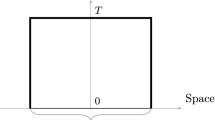Abstract
We study space-time fluctuations around a characteristic line for a one-dimensional interacting system known as the random average process. The state of this system is a real-valued function on the integers. New values of the function are created by averaging previous values with random weights. The fluctuations analyzed occur on the scale n 1/4, where n is the ratio of macroscopic and microscopic scales in the system. The limits of the fluctuations are described by a family of Gaussian processes. In cases of known product-form invariant distributions, this limit is a two-parameter process whose time marginals are fractional Brownian motions with Hurst parameter 1/4. Along the way we study the limits of quenched mean processes for a random walk in a space-time random environment. These limits also happen at scale n 1/4 and are described by certain Gaussian processes that we identify. In particular, when we look at a backward quenched mean process, the limit process is the solution of a stochastic heat equation.
Similar content being viewed by others
References
Aldous D., Diaconis P. (1995) Hammersley’s interacting particle process and longest increasing subsequences. Probab. Theory Related Fields 103(2): 199–213
Aldous D., Diaconis P. (1999) Longest increasing subsequences: from patience sorting to the Baik-Deift-Johansson theorem. Bull. Amer. Math. Soc. (N.S.) 36(4): 413–432
Baik J., Deift P., Johansson K. (1999) On the distribution of the length of the longest increasing subsequence of random permutations. J. Amer. Math. Soc. 12(4): 1119–1178
Balázs M. (2003) Growth fluctuations in a class of deposition models. Ann. Inst. H. Poincaré Probab. Statist. 39(4): 639–685
Bernabei M.S. (2001) Anomalous behaviour for the random corrections to the cumulants of random walks in fluctuating random media. Probab. Theory Related Fields 119(3): 410–432
Boldrighini C., Pellegrinotti A. T −1/4-noise for random walks in dynamic environment on \(\mathbb{Z}\). Mosc. Math. J. 1(3), 365–380 470–471 (2001)
Burkholder D.L. (1973) Distribution function inequalities for martingales. Ann. Probab. 1, 19–42
Chung, K.L. Markov chains with stationary transition probabilities. In: Die Grundlehren der mathematischen Wissenschaften, Band 104. New York: Springer-Verlag Second edition, 1967
De Masi A., Presutti E. (1991) Mathematical methods for hydrodynamic limits, Volume 1501 of Lecture Notes in Mathematics. Springer-Verlag, Berlin
Deift P. (2000) Integrable systems and combinatorial theory. Notices Amer. Math. Soc. 47(6): 631–640
Durrett R. (2004) Probability: theory and examples. Duxbury Advanced Series. Brooks/Cole–Thomson, Belmont, CA, Third edition
Ethier S.N., Kurtz T.G. (1986) Markov processes. Wiley Series in Probability and Mathematical Statistics: Probability and Mathematical Statistics. John Wiley & Sons Inc., New York
Ferrari P.A., Fontes L.R.G. (1994) Current fluctuations for the asymmetric simple exclusion process. Ann. Probab. 22(2): 820–832
Ferrari, P.A., Fontes, L.R.G. Fluctuations of a surface submitted to a random average process. Electron. J. Probab. 3, no. 6, 34 pp., (1998) (electronic)
Ferrari, P.L., Spohn, H Scaling Limit for the Space-Time Covariance of the Stationary Totally Asymmetric Simple Exclusion Process. Commum. Math. Phys. (2006) (in press)
Gravner J., Tracy C.A., Widom H. (2001) Limit theorems for height fluctuations in a class of discrete space and time growth models. J. Stat. Phys. 102(5–6): 1085–1132
Groeneboom P. (2002) Hydrodynamical methods for analyzing longest increasing subsequences. J. Comput. Appl. Math. 142(1): 83–105
Hammersley, J.M. A few seedlings of research. In: Proceedings of the Sixth Berkeley Symposium on Mathematical Statistics and Probability (Univ. California, Berkeley, Calif., 1970/1971), Vol. I: Theory of statistics, Berkeley, Univ. California Press, 1972, pp. 345–394
Johansson K. (2000) Shape fluctuations and random matrices. Commun. Math. Phys. 209(2): 437–476
Johansson, K. Discrete orthogonal polynomial ensembles and the Plancherel measure. Ann. Math. (2) 153(1), 259–296 (2001)
Kipnis C., Landim C. (1999) Scaling limits of interacting particle systems. Volume 320 of Grundlehren der Mathematischen Wissenschaften [Fundamental Principles of Mathematical Sciences], Springer-Verlag, Berlin
Liggett T.M. (1985) Interacting particle systems. Volume 276 of fcGrundlehren der Mathematischen Wissenschaften [Fundamental Principles of Mathematical Sciences], Springer-Verlag, New York
Liggett T.M. (1999) Stochastic interacting systems: contact, voter and exclusion processes. Volume 324 of Grundlehren der Mathematischen Wissenschaften [Fundamental Principles f Mathematical Sciences], Springer-Verlag, Berlin
Rassoul-Agha, F., Seppäläinen, T. An almost sure invariance principle for random walks in a space-time random environment. Probab. The. Rel. Fields 133, no. 3, 299–314 (2005)
Rezakhanlou F. (2002) A central limit theorem for the asymmetric simple exclusion process. Ann. Inst. H. Poincaré Probab. Statist. 38(4): 437–464
Seppäläinen, T. A microscopic model for the Burgers equation and longest increasing subsequences. Electron. J. Probab. 1, no. 5, approx. 51 pp., (1996) (electronic)
Seppäläinen T. (1998) Exact limiting shape for a simplified model of first-passage percolation on the plane. Ann. Probab. 26(3): 1232–1250
Seppäläinen T. (1998) Large deviations for increasing sequences on the plane. Probab. Th. Rel. Fields 112(2): 221–244
Seppäläinen T. (2002) Diffusive fluctuations for one-dimensional totally asymmetric interacting random dynamics. Commun. Math. Phys. 229(1): 141–182
Seppäläinen T. (2005) Second-order fluctuations and current across characteristic for a one-dimensional growth model of independent random walks. Ann. Probab. 33(2): 759–797
Spitzer F. (1976) Principles of random walk. Springer-Verlag, New York
Spohn H. (1991) Large scale dynamics of interacting particles. Springer-Verlag, Berlin
Varadhan, S.R.S. Lectures on hydrodynamic scaling. In Hydrodynamic limits and related topics (Toronto, ON, 1998), Volume 27 of Fields Inst. Commun., Providence, RI: Amer. Math. Soc., 2000, pp. 3–40
Walsh, J.B. An introduction to stochastic partial differential equations. In: École d’été de probabilités de Saint-Flour, XIV—1984, Volume 1180 of Lecture Notes in Math., Berlin: Springer, 1986, pp. 265–439
Author information
Authors and Affiliations
Corresponding author
Additional information
Communicated by H. Spohn
M. Balázs was partially supported by Hungarian Scientific Research Fund (OTKA) grant T037685.
T. Seppäläinen was partially supported by National Science Foundation grant DMS-0402231.
Rights and permissions
About this article
Cite this article
Balázs, M., Rassoul-Agha, F. & Seppäläinen, T. The Random Average Process and Random Walk in a Space-Time Random Environment in One Dimension. Commun. Math. Phys. 266, 499–545 (2006). https://doi.org/10.1007/s00220-006-0036-y
Received:
Accepted:
Published:
Issue Date:
DOI: https://doi.org/10.1007/s00220-006-0036-y




